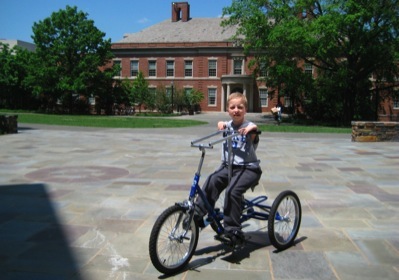Project summary
Kevin Caves, Instructor in Biomedical Engineering,and Director of the Rehabilitation Engineering Research Center on Communication Enhancement, participated in a CIT’s Instructional Technology Faculty Fellows program, to share ideas about teaching with video with other faculty.
 For Kevin Caves’ capstone course in Biomedical Engineering, students work in teams to design, build and deliver customized assistive devices for people with disabilities in the community. In the past, students have demonstrated their devices for a final presentation. This time, students used Flip video cameras provided by the Duke Digital Initiative to record interviews with disabled clients, in which the clients explain what they can do on their own, and later, what they can do with assistive prototypes.
For Kevin Caves’ capstone course in Biomedical Engineering, students work in teams to design, build and deliver customized assistive devices for people with disabilities in the community. In the past, students have demonstrated their devices for a final presentation. This time, students used Flip video cameras provided by the Duke Digital Initiative to record interviews with disabled clients, in which the clients explain what they can do on their own, and later, what they can do with assistive prototypes.
Students could use these videos as a memory aid, as they were designing devices. The videos also helped instructors, who can’t always attend each meeting with the clients, to review what happened during a visit.
In addition, students used video to demonstrate their designed devices as a final presentation. A video has advantages over a live demonstration, as “It allows students to be sure that their demonstration will work because it’s been done a couple of days before,” says Caves. “It also allows them to focus in on a particular feature that they want to highlight; they can edit it; they can put text over it; they can edit-in still photographs of things. It’s really helped to improve the quality of those presentations.”
Caves adds, “The nice thing about the Flip is that you flip it on, and you start recording.” What he didn’t like as much was the audio. Students typically have to record voiceovers separately to ensure decent sound quality for the presentations.
 Using the Flip was easy for Caves’ students, but editing was another matter. “All the students across the board said, ‘Video editing is hard.’ In general it was one student in each group who said, ‘I’ll take it on,'” he explains.
Using the Flip was easy for Caves’ students, but editing was another matter. “All the students across the board said, ‘Video editing is hard.’ In general it was one student in each group who said, ‘I’ll take it on,'” he explains.
“One thing we didn’t think about was permissions.” Once the work was done, students wanted to post their videos to YouTube, but didn’t have a release form from the clients or families involved.
Cave’s advice about using video for student projects: “I can’t see any reason not to.” See three examples of his students’ projects and share the client’s delight, below:
